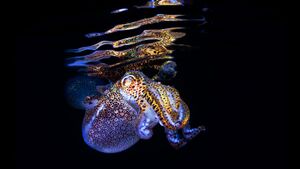Role of the Lux Operon in Bioluminescence: Difference between revisions
No edit summary |
|||
| Line 24: | Line 24: | ||
<sup>I don't know</sup> | <sup>I don't know</sup> | ||
==Section 1 | ==Section 1 Microbiome== | ||
Include some current research, with at least one image.<br><br> | Include some current research, with at least one image.<br><br> | ||
Revision as of 13:14, 8 December 2021
Introduction
The lux operon has long been studied for its unique gene product: bioluminescence. Found in the bacterium Vibrio fischeri, the lux operon is an essential part of the bacterium's genetic code. In fact, the bacterial bioluminescence produced by the Vibrio fischeri bacteria plays an essential role in many mutualistic relationships with other organisms. One such organism is the Hawaiian Bobtail Squid (Euprymna scolopes).
The mutualistic relationship that exists between the Hawaiian Bobtail Squid and its bacterial partner Vibrio fischeri

At right is a sample image insertion. It works for any image uploaded anywhere to MicrobeWiki. The insertion code consists of:
Double brackets: [[
Filename: PHIL_1181_lores.jpg
Thumbnail status: |thumb|
Pixel size: |300px|
Placement on page: |right|
Legend/credit: Electron micrograph of the Ebola Zaire virus. This was the first photo ever taken of the virus, on 10/13/1976. By Dr. F.A. Murphy, now at U.C. Davis, then at the CDC.
Closed double brackets: ]]
Other examples:
Bold
Italic
Subscript: H2O
Superscript: Fe3+
I don't know
Section 1 Microbiome
Include some current research, with at least one image.
Section 2 Microbiome
Include some current research, with a second image.
Conclusion
Overall text length (all text sections) should be at least 1,000 words (before counting references), with at least 2 images.
Include at least 5 references under References section.
References
Citations: [1]
[2]
A citation code consists of a hyperlinked reference within "ref" begin and end codes.
Edited by Lauren Lehr, student of Joan Slonczewski for BIOL 116 Information in Living Systems, 2021, Kenyon College./
- ↑ Swartzman, A., Shalini Kapoor, A. F. Graham, and EDWARD A. Meighen. "A new Vibrio fischeri lux gene precedes a bidirectional termination site for the lux operon." Journal of bacteriology 172, no. 12 (1990): 6797-6802.
- ↑ Lyell, Noreen L., Anne K. Dunn, Jeffrey L. Bose, and Eric V. Stabb. "Bright mutants of Vibrio fischeri ES114 reveal conditions and regulators that control bioluminescence and expression of the lux operon." Journal of bacteriology 192, no. 19 (2010): 5103-5114.
